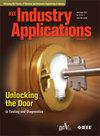封闭式自然对流PFC-LLC GaN变换器的综合系统级热性能和功率密度优化
IF 4.2
2区 工程技术
Q2 ENGINEERING, ELECTRICAL & ELECTRONIC
引用次数: 0
摘要
GaN增强型高电子迁移率晶体管(e- hemt)擅长将效率最大化到可能的极端。随着按需功率密度的增加和效率接近饱和点,对半导体可靠性和热管理的关注加剧。本文重点研究了基于gan的两级PFC-LLC转换器,这是自然冷却消费电子产品中普遍存在的拓扑结构,并探讨了解决其热瓶颈的解决方案。提出了一个平衡热网络,该网络通过精确的温度相关损耗表征,将热畴和电畴互连起来。然后将这些损耗模型传递到功率转换器的热网中。此外,热耦合的概念,主要发展在组件级的研究,扩展到系统级功率转换器。各种设计的微妙之处,包括适当的元件放置和PCB设计,旨在提高GaN的结对环境热阻($R_{th,ja}$),导航。最后,本文引入了考虑热边界的最大功率密度实现框架,并给出了多目标优化(MOO)问题的Pareto前沿,解释了功率密度与热性能的权衡。一旦确定了其他转换器独特的温度相关损耗模型,所提出的想法就可以用于其他转换器。有限元分析(FEA)和实验结果支持了这些说法。本文章由计算机程序翻译,如有差异,请以英文原文为准。
Comprehensive System-Level Thermal Performance and Power Density Optimization in Enclosed Natural Convection PFC-LLC GaN Converters
GaN enhancement-mode high electron mobility transistors (e-HEMTs) excel at maximizing efficiency to possible extremes. With on-demand power density increase and efficiency approaching the saturation points, concerns regarding semiconductor reliability and thermal management intensify. This paper focuses on the two-stage GaN-based PFC-LLC converter, a prevalent topology in naturally-cooled consumer electronics, and explores solutions to address its thermal bottlenecks. An equilibrium thermal network is proposed, which is established by interconnecting thermal and electrical domains through accurate temperature-dependent loss characterization. These loss models are then transferred into the thermal network of the power converter. Furthermore, the concept of thermo-coupling, primarily developed in component-level studies, is expanded into system-level power converters. Various design subtleties, including proper component placement and PCB design aimed at enhancing GaN's junction-to-ambient thermal resistance ($R_{th,ja}$
求助全文
通过发布文献求助,成功后即可免费获取论文全文。
去求助
来源期刊

IEEE Transactions on Industry Applications
工程技术-工程:电子与电气
CiteScore
9.90
自引率
9.10%
发文量
747
审稿时长
3.3 months
期刊介绍:
The scope of the IEEE Transactions on Industry Applications includes all scope items of the IEEE Industry Applications Society, that is, the advancement of the theory and practice of electrical and electronic engineering in the development, design, manufacture, and application of electrical systems, apparatus, devices, and controls to the processes and equipment of industry and commerce; the promotion of safe, reliable, and economic installations; industry leadership in energy conservation and environmental, health, and safety issues; the creation of voluntary engineering standards and recommended practices; and the professional development of its membership.
 求助内容:
求助内容: 应助结果提醒方式:
应助结果提醒方式:


